YAMAHA GRIZZLY 125 2010 Owners Manual
Manufacturer: YAMAHA, Model Year: 2010, Model line: GRIZZLY 125, Model: YAMAHA GRIZZLY 125 2010Pages: 132, PDF Size: 4.16 MB
Page 111 of 132
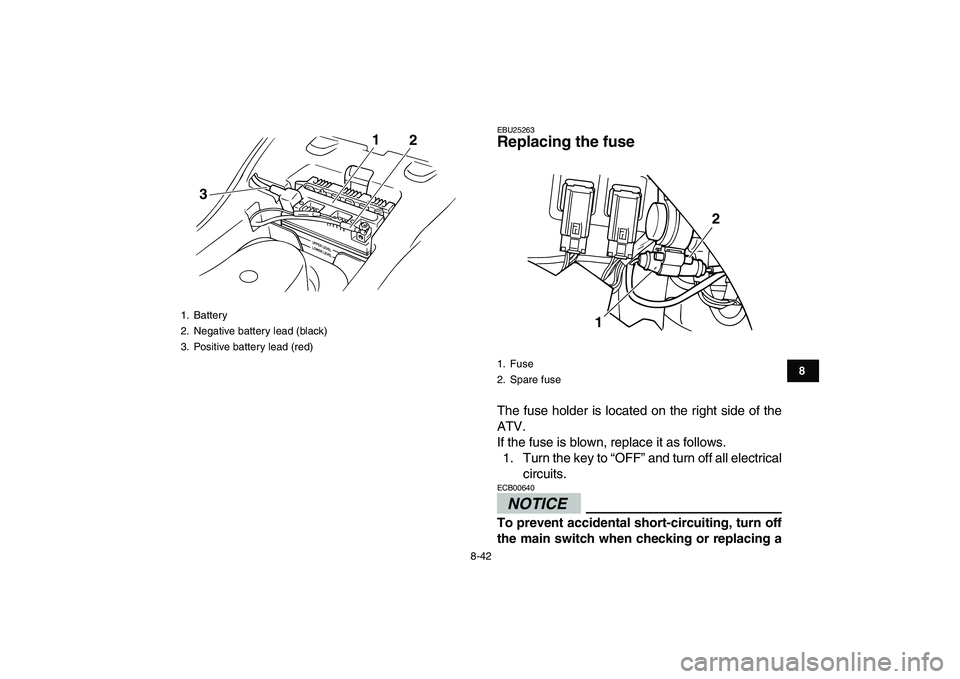
8-42
1
2
3
4
5
6
78
9
10
11
EBU25263
Replacing the fuse
The fuse holder is located on the right side of the
ATV.
If the fuse is blown, replace it as follows.
1. Turn the key to “OFF” and turn off all electrical
circuits.NOTICE
ECB00640
To prevent accidental short-circuiting, turn off
the main switch when checking or replacing a
1. Battery
2. Negative battery lead (black)
3. Positive battery lead (red)
1
2
3
1. Fuse
2. Spare fuse
12
Page 112 of 132
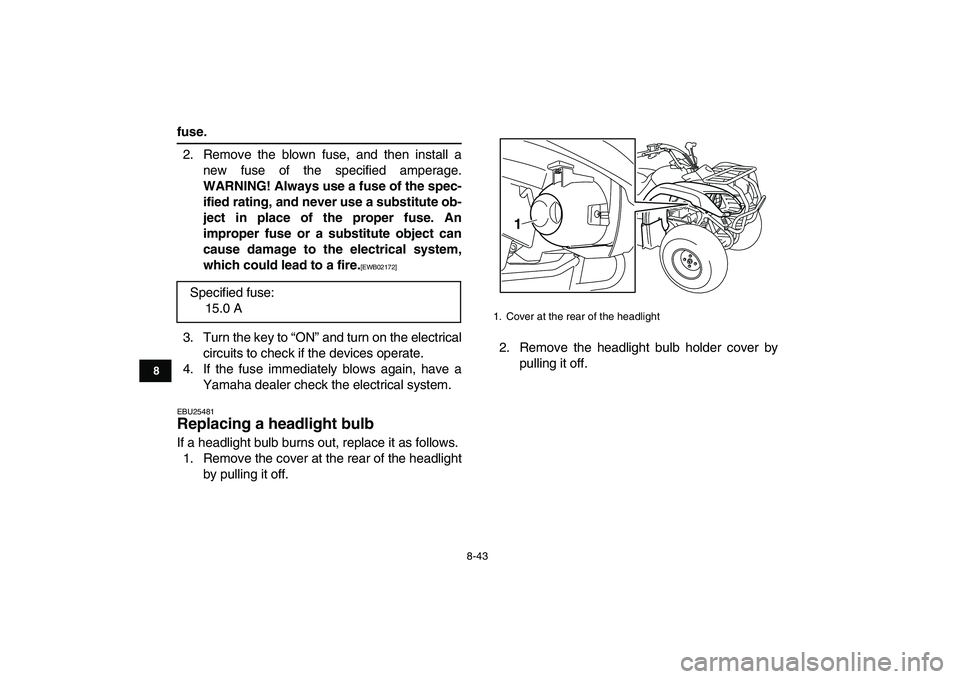
8-43
1
2
3
4
5
6
78
9
10
11
fuse.
2. Remove the blown fuse, and then install a
new fuse of the specified amperage.
WARNING! Always use a fuse of the spec-
ified rating, and never use a substitute ob-
ject in place of the proper fuse. An
improper fuse or a substitute object can
cause damage to the electrical system,
which could lead to a fire.
[EWB02172]
3. Turn the key to “ON” and turn on the electrical
circuits to check if the devices operate.
4. If the fuse immediately blows again, have a
Yamaha dealer check the electrical system.
EBU25481
Replacing a headlight bulb
If a headlight bulb burns out, replace it as follows.
1. Remove the cover at the rear of the headlight
by pulling it off.2. Remove the headlight bulb holder cover by
pulling it off. Specified fuse:
15.0 A
1. Cover at the rear of the headlight1
Page 113 of 132
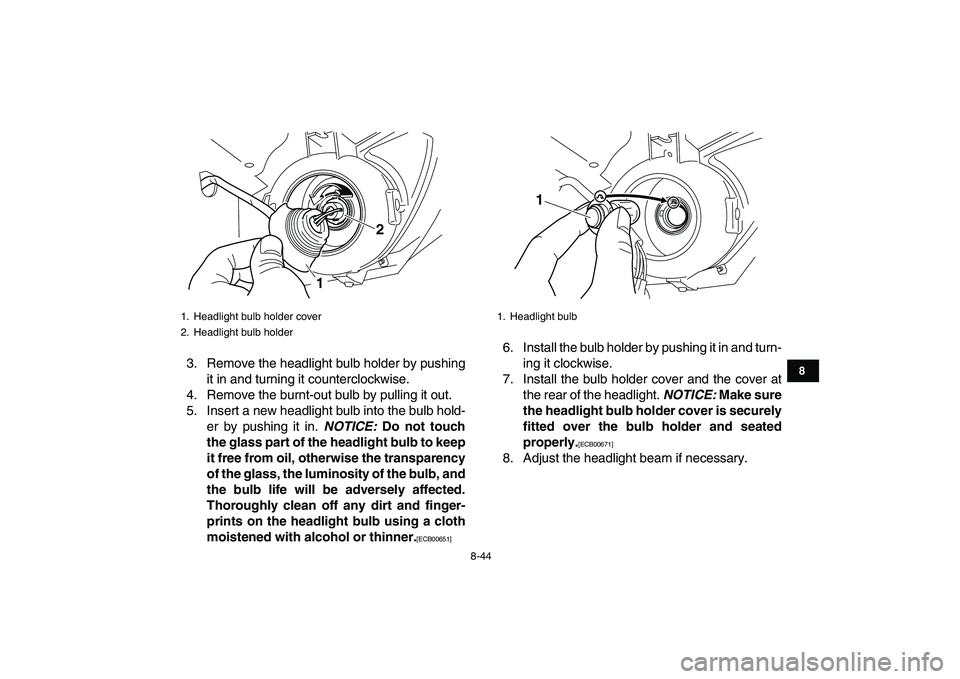
8-44
1
2
3
4
5
6
78
9
10
11
3. Remove the headlight bulb holder by pushing
it in and turning it counterclockwise.
4. Remove the burnt-out bulb by pulling it out.
5. Insert a new headlight bulb into the bulb hold-
er by pushing it in.
NOTICE:
Do not touch
the glass part of the headlight bulb to keep
it free from oil, otherwise the transparency
of the glass, the luminosity of the bulb, and
the bulb life will be adversely affected.
Thoroughly clean off any dirt and finger-
prints on the headlight bulb using a cloth
moistened with alcohol or thinner.
[ECB00651]
6. Install the bulb holder by pushing it in and turn-
ing it clockwise.
7. Install the bulb holder cover and the cover at
the rear of the headlight.
NOTICE:
Make sure
the headlight bulb holder cover is securely
fitted over the bulb holder and seated
properly.
[ECB00671]
8. Adjust the headlight beam if necessary.
1. Headlight bulb holder cover
2. Headlight bulb holder
12
1. Headlight bulb1
Page 114 of 132
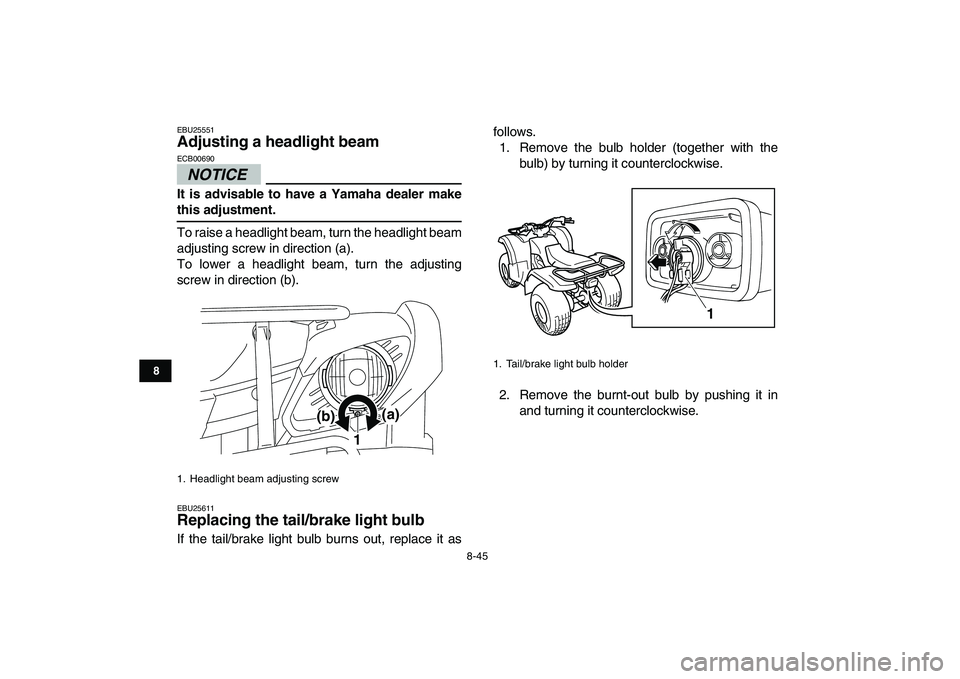
8-45
1
2
3
4
5
6
78
9
10
11
EBU25551
Adjusting a headlight beam
NOTICE
ECB00690
It is advisable to have a Yamaha dealer make
this adjustment.
To raise a headlight beam, turn the headlight beam
adjusting screw in direction (a).
To lower a headlight beam, turn the adjusting
screw in direction (b).
EBU25611
Replacing the tail/brake light bulb
If the tail/brake light bulb burns out, replace it asfollows.
1. Remove the bulb holder (together with the
bulb) by turning it counterclockwise.
2. Remove the burnt-out bulb by pushing it in
and turning it counterclockwise.
1. Headlight beam adjusting screw
1(a)
(b)
1. Tail/brake light bulb holder
1
Page 115 of 132
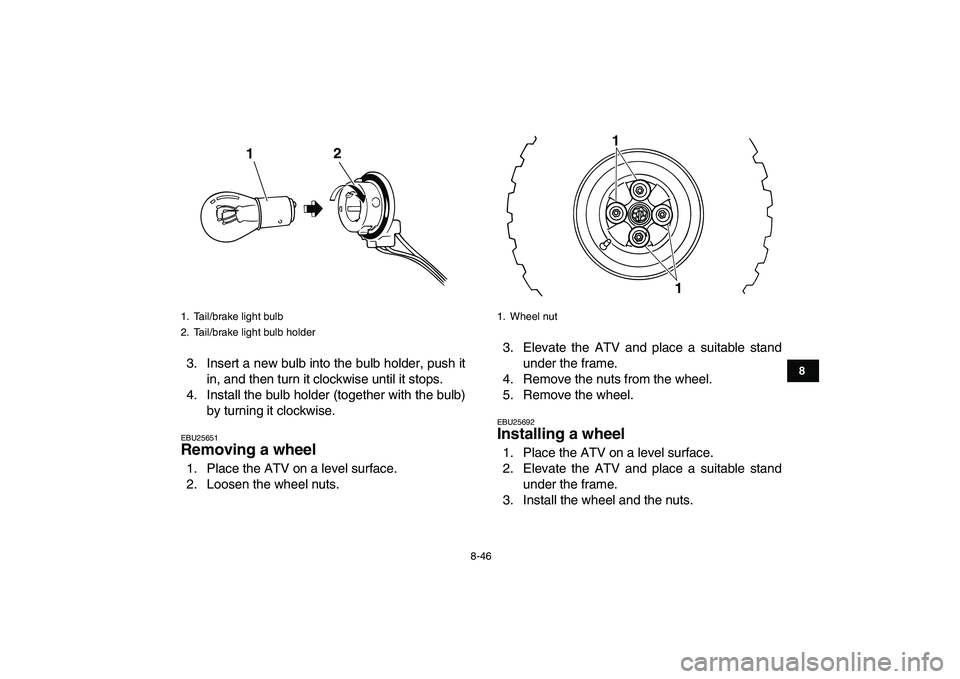
8-46
1
2
3
4
5
6
78
9
10
11
3. Insert a new bulb into the bulb holder, push it
in, and then turn it clockwise until it stops.
4. Install the bulb holder (together with the bulb)
by turning it clockwise.
EBU25651
Removing a wheel
1. Place the ATV on a level surface.
2. Loosen the wheel nuts.3. Elevate the ATV and place a suitable stand
under the frame.
4. Remove the nuts from the wheel.
5. Remove the wheel.
EBU25692
Installing a wheel
1. Place the ATV on a level surface.
2. Elevate the ATV and place a suitable stand
under the frame.
3. Install the wheel and the nuts.
1. Tail/brake light bulb
2. Tail/brake light bulb holder
12
1. Wheel nut
1
1
Page 116 of 132

8-47
1
2
3
4
5
6
78
9
10
11
TIP
Tapered nuts are used for both the front and rear
wheels. Install the nuts with their tapered side to-
wards the wheel.
4. Lower the ATV to the ground.
5. Tighten the wheel nuts to the specified
torques.
EBU25720
Troubleshooting
Although Yamaha ATVs receive a thorough in-
spection before shipment from the factory, trouble
may occur during operation. Any problem in the fu-
el, compression, or ignition systems, for example,
can cause poor starting and loss of power.
The following troubleshooting chart represents a
quick and easy procedure for checking these vital
systems yourself. However, should your ATV re-
quire any repair, take it to a Yamaha dealer, whose
skilled technicians have the necessary tools, expe-
rience, and know-how to service the ATV properly.
Use only genuine Yamaha replacement parts. Im-
itation parts may look like Yamaha parts, but they
are often inferior, have a shorter service life and
can lead to expensive repair bills.
1. Tapered nut
1
Tightening torques:
Front wheel nut:
55 Nm (5.5 m·kgf, 39.8 ft·lbf)
Rear wheel nut:
55 Nm (5.5 m·kgf, 39.8 ft·lbf)
Page 117 of 132
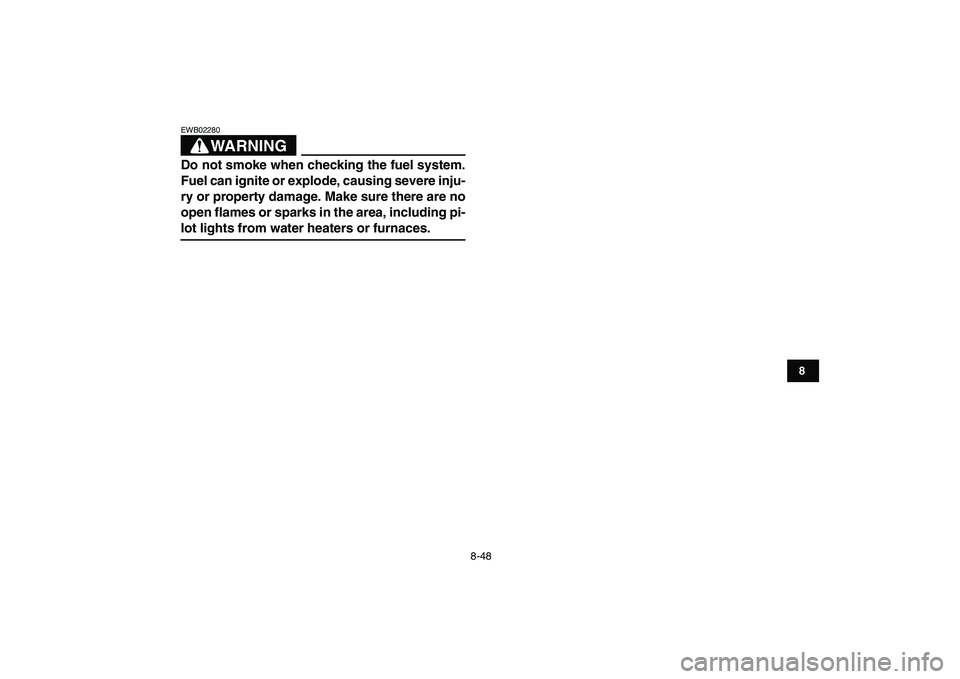
8-48
1
2
3
4
5
6
78
9
10
11
WARNING
EWB02280
Do not smoke when checking the fuel system.
Fuel can ignite or explode, causing severe inju-
ry or property damage. Make sure there are no
open flames or sparks in the area, including pi-
lot lights from water heaters or furnaces.
Page 118 of 132
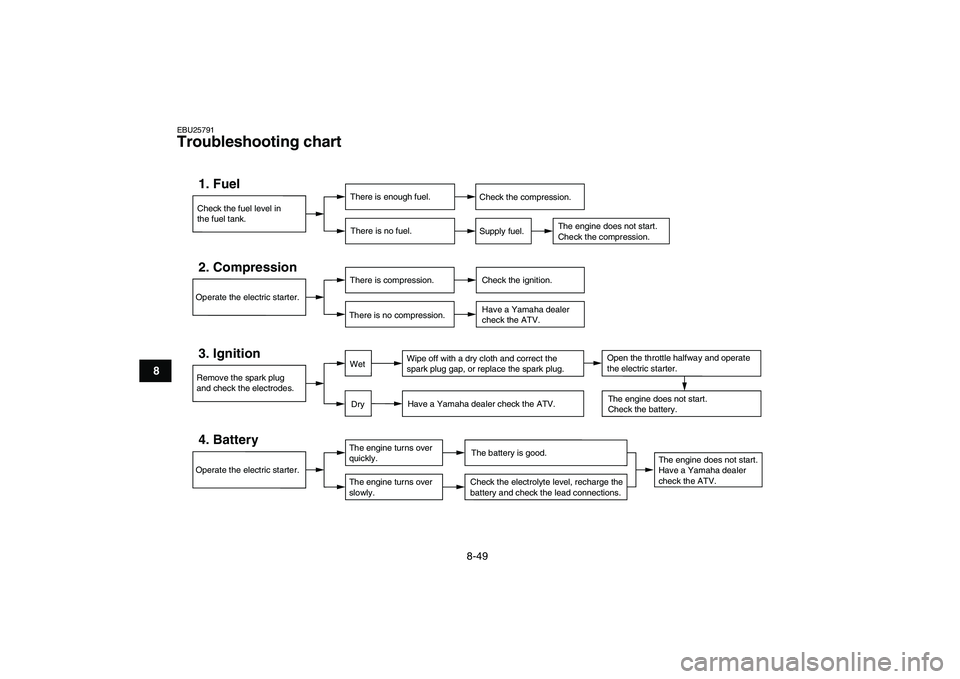
8-49
1
2
3
4
5
6
78
9
10
11
EBU25791
Troubleshooting chart
Check the fuel level in
the fuel tank.1. Fuel
There is enough fuel.
There is no fuel.
Check the compression.
Supply fuel.
The engine does not start.
Check the compression.
Operate the electric starter.2. Compression
There is compression.
There is no compression.
Check the ignition.
Have a Yamaha dealer
check the ATV.
Remove the spark plug
and check the electrodes.3. Ignition
Wipe off with a dry cloth and correct the
spark plug gap, or replace the spark plug.
Have a Yamaha dealer check the ATV.
The engine does not start.
Have a Yamaha dealer
check the ATV.
The engine does not start.
Check the battery.
Operate the electric starter.4. Battery
The engine turns over
quickly.
The engine turns over
slowly.
The battery is good.Check the electrolyte level, recharge the
battery and check the lead connections.
DryWet
Open the throttle halfway and operate
the electric starter.
Page 119 of 132
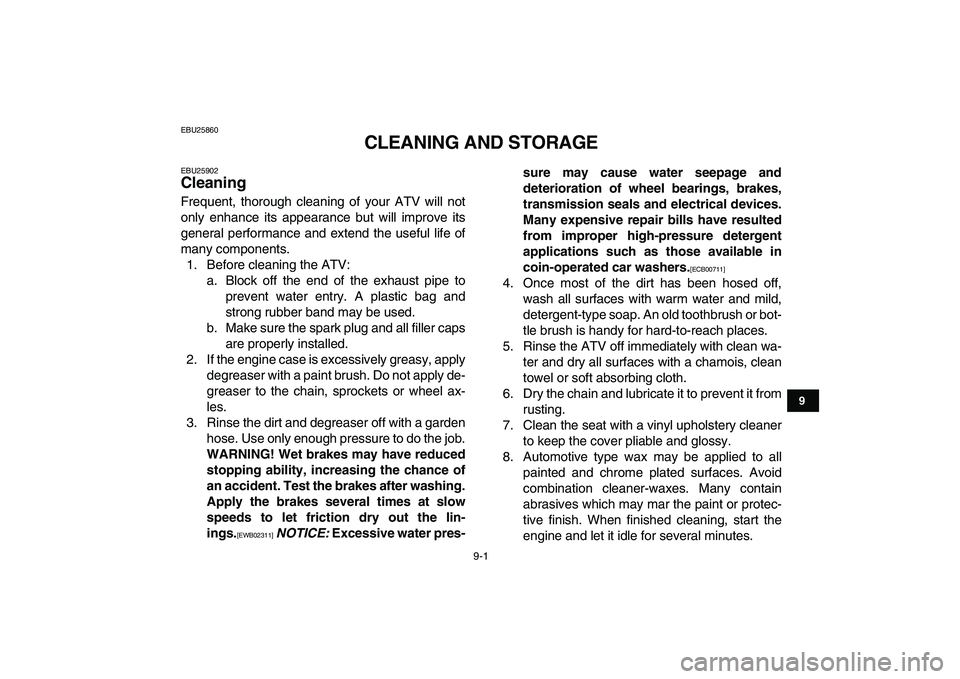
9-1
1
2
3
4
5
6
7
89
10
11
EBU25860
CLEANING AND STORAGE
EBU25902
Cleaning
Frequent, thorough cleaning of your ATV will not
only enhance its appearance but will improve its
general performance and extend the useful life of
many components.
1. Before cleaning the ATV:
a. Block off the end of the exhaust pipe to
prevent water entry. A plastic bag and
strong rubber band may be used.
b. Make sure the spark plug and all filler caps
are properly installed.
2. If the engine case is excessively greasy, apply
degreaser with a paint brush. Do not apply de-
greaser to the chain, sprockets or wheel ax-
les.
3. Rinse the dirt and degreaser off with a garden
hose. Use only enough pressure to do the job.
WARNING! Wet brakes may have reduced
stopping ability, increasing the chance of
an accident. Test the brakes after washing.
Apply the brakes several times at slow
speeds to let friction dry out the lin-
ings.
[EWB02311]
NOTICE:
Excessive water pres-sure may cause water seepage and
deterioration of wheel bearings, brakes,
transmission seals and electrical devices.
Many expensive repair bills have resulted
from improper high-pressure detergent
applications such as those available in
coin-operated car washers.
[ECB00711]
4. Once most of the dirt has been hosed off,
wash all surfaces with warm water and mild,
detergent-type soap. An old toothbrush or bot-
tle brush is handy for hard-to-reach places.
5. Rinse the ATV off immediately with clean wa-
ter and dry all surfaces with a chamois, clean
towel or soft absorbing cloth.
6. Dry the chain and lubricate it to prevent it from
rusting.
7. Clean the seat with a vinyl upholstery cleaner
to keep the cover pliable and glossy.
8. Automotive type wax may be applied to all
painted and chrome plated surfaces. Avoid
combination cleaner-waxes. Many contain
abrasives which may mar the paint or protec-
tive finish. When finished cleaning, start the
engine and let it idle for several minutes.
Page 120 of 132
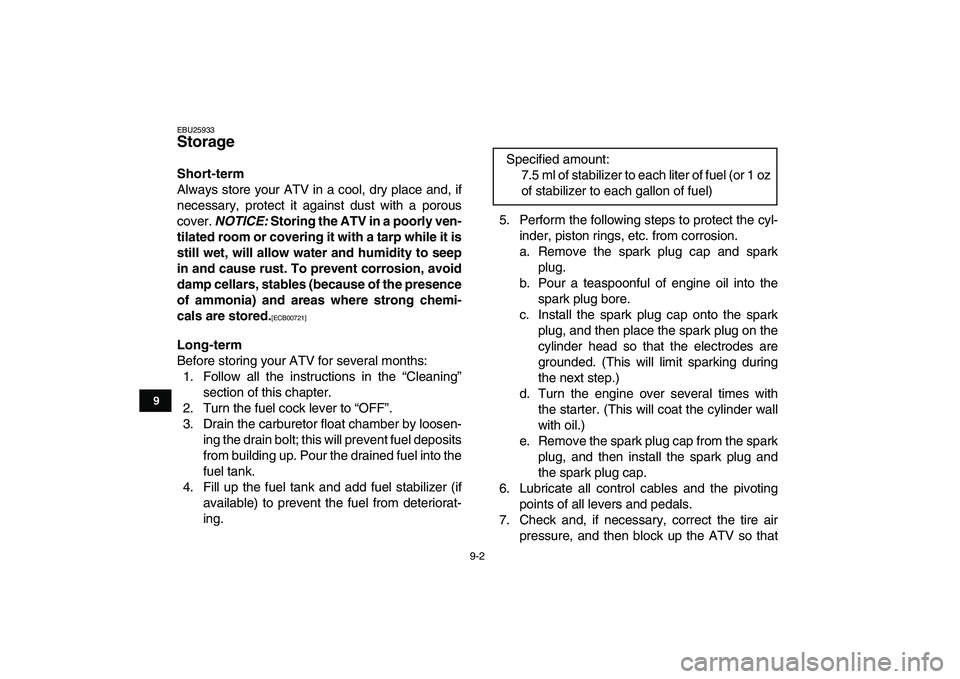
9-2
1
2
3
4
5
6
7
89
10
11
EBU25933
Storage
Short-term
Always store your ATV in a cool, dry place and, if
necessary, protect it against dust with a porous
cover.
NOTICE:
Storing the ATV in a poorly ven-
tilated room or covering it with a tarp while it is
still wet, will allow water and humidity to seep
in and cause rust. To prevent corrosion, avoid
damp cellars, stables (because of the presence
of ammonia) and areas where strong chemi-
cals are stored.
[ECB00721]
Long-term
Before storing your ATV for several months:
1. Follow all the instructions in the “Cleaning”
section of this chapter.
2. Turn the fuel cock lever to “OFF”.
3. Drain the carburetor float chamber by loosen-
ing the drain bolt; this will prevent fuel deposits
from building up. Pour the drained fuel into the
fuel tank.
4. Fill up the fuel tank and add fuel stabilizer (if
available) to prevent the fuel from deteriorat-
ing.5. Perform the following steps to protect the cyl-
inder, piston rings, etc. from corrosion.
a. Remove the spark plug cap and spark
plug.
b. Pour a teaspoonful of engine oil into the
spark plug bore.
c. Install the spark plug cap onto the spark
plug, and then place the spark plug on the
cylinder head so that the electrodes are
grounded. (This will limit sparking during
the next step.)
d. Turn the engine over several times with
the starter. (This will coat the cylinder wall
with oil.)
e. Remove the spark plug cap from the spark
plug, and then install the spark plug and
the spark plug cap.
6. Lubricate all control cables and the pivoting
points of all levers and pedals.
7. Check and, if necessary, correct the tire air
pressure, and then block up the ATV so that Specified amount:
7.5 ml of stabilizer to each liter of fuel (or 1 oz
of stabilizer to each gallon of fuel)